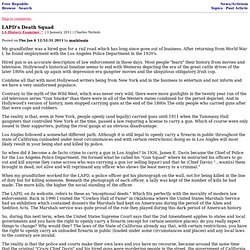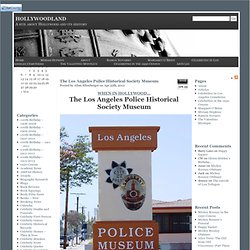

The LAPD: 1926-1950. When James E.

Davis became Chief in 1926, he formed a 50-man "gun squad" announcing that "the gun-toting element and the rum smugglers are going to learn that murder and gun-toting are most inimical to their best interest. " He added that he would "hold court on gunmen in the Los Angeles streets; I want them brought in dead, not alive and will reprimand any officer who shows the least mercy to a criminal. " In addition to stressing marksmanship, Davis sought successfully to make LAPD officers known worldwide as firearm experts.
He initiated the dragnet system for tracking down wanted criminals, stressed the value of statistics for determining crime trends, and fired more than 240 officers for "bad conduct. " Davis' successor, Chief Roy E. A highlight of Chief Steckel's term occurred in 1931 with the implementation of what was called "the most modern municipal police radio system in the world. " With his return to office in 1933, Chief James E. Arthur C. LAPD's Death Squad. Skip to comments.

LAPD's Death Squad LA History Examiner ^ | 3 January, 2011 | Charles Nichols Posted on Thu Jan 6 12:52:31 2011 by marktwain My grandfather was a hired gun for a rail road which has long since gone out of business. After returning from World War I, he found employment with the Los Angeles Police Department in the 1920's.
Hired gun is an accurate description of law enforcement in those days. Combine all that with most Hollywood writers being from New York and in the business to entertain and not inform and we have a very uninformed populace. Contrary to the myth of the Wild West, which was never very wild, there were more gunfights in the twenty year run of the old television series "Gun Smoke" than there were in all of the Western states combined for the period depicted. Los Angles followed a somewhat different path. So when did it become a de facto crime to carry a gun in Los Angles?
The LAPD, on its web-site, refers to these as "exceptional deeds. " Los Angeles Police Museum. HOLLYWOODLAND » Blog Archive » The Los Angeles Police Historical Society Museum. By Allan R.

Ellenberger From time to time, Hollywoodland will suggest places of interest for visitors to the film capital or to those of you have lived here your entire life but have never seen some of our city’s most interesting sights. That said, today’s suggestion is not in the vicinity of Hollywood but is still worth the eleven mile drive to Highland Park to visit the Los Angeles Police Historical Society Museum.
Housed in an actual 1926 police station, the museum displays historical memorabilia pertaining to the Los Angeles police department from the late 1800s to the present. Police vehicles from several decades are on display and there are real jail cells where you can experience what it’s like being incarcerated. Above is a police car that was involved in the 1997 North Hollywood Shootout Currently there is a unique limited exhibition about the 1947 murder of Elizabeth Short, better known as the “Black Dahlia.”
“Black Dahlia” afficianado, Allison Francis, examines Get “locked up” MacArthur Park: from Riches, to Rags, to Revitalization? By Brooke Theodora From idyllic boating park to gang playground, MacArthur Park's stereotype sure has changed a lot in the last 150 years.

For Angelenos, the relatively small park bordered by Alvarado, Sixth, Seventh and South Park View streets has stood for many different things over the decades -- and has seen some serious degradation. But for future generations, the park stands for hope -- in the form of a cooperation between cultural celebration and historical revitalization. Just how that cooperation -- a simultaneous juggle between the interests of a predominantly Hispanic working class and the legitimate renovation of what can be considered glamorous Old Hollywood -- will coexist in MacArthur Park is the problem. But before we address that hiccup in the city's plan of revitalization: a brief history of MacArthur Park. It all began in the late 1800s, when the city of Los Angeles received a 35-acre refuse dump located to the west of what would become modern-day Downtown.
Www.laphs.org/docs/blue-in-history-section.pdf.